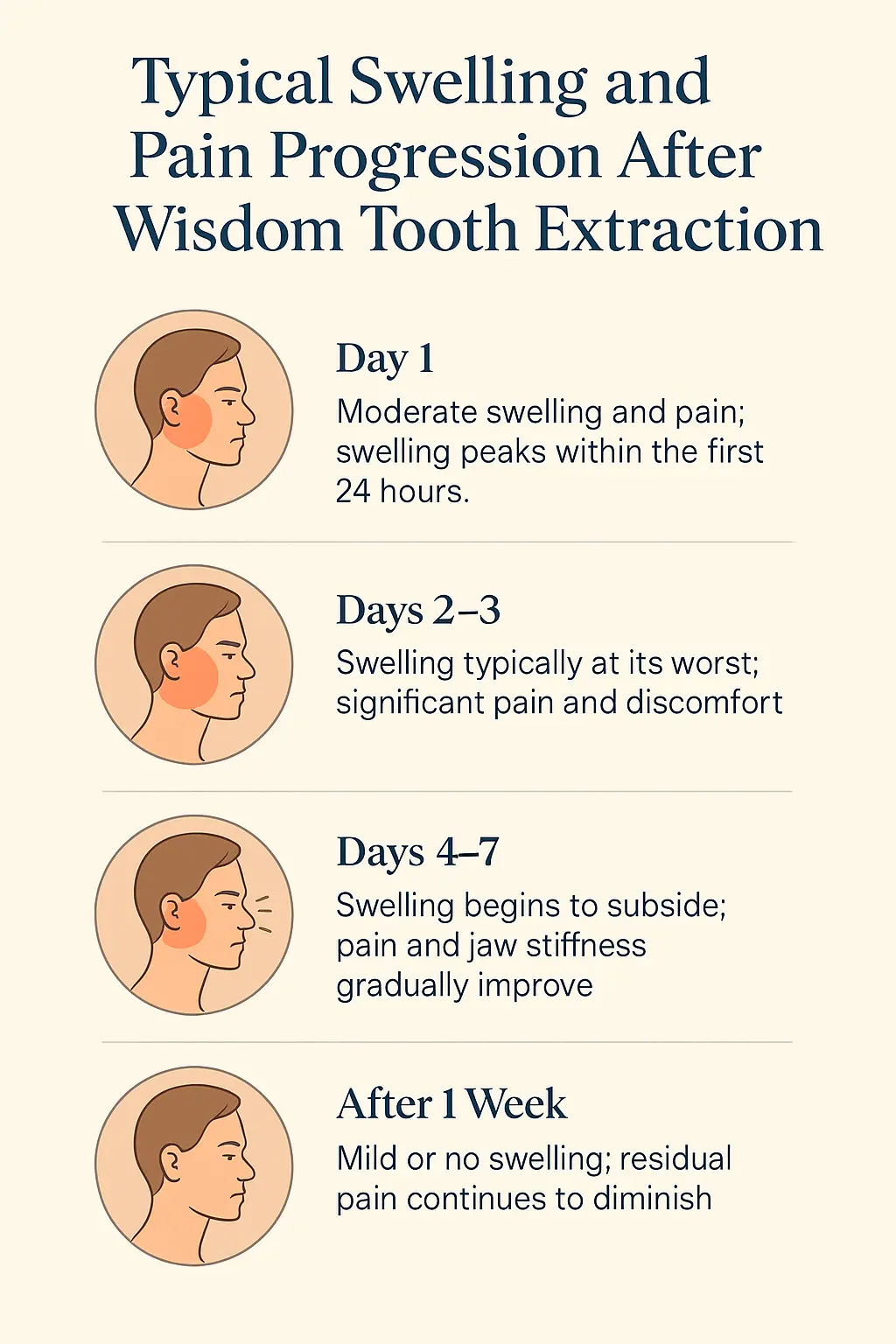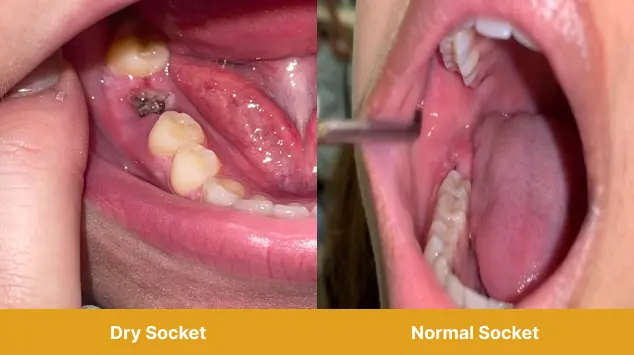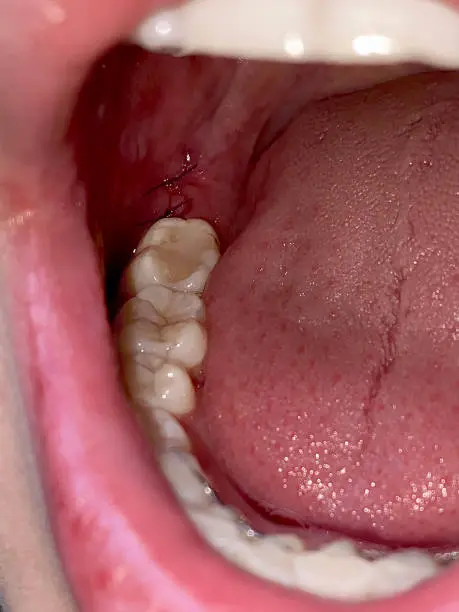Have you recently had your wisdom teeth removed and now experiencing what feels like the worst pain ever? Many patients find that the discomfort reaches its peak between the second and third day after surgery rather than immediately following the procedure. This catches many people off guard, making an already challenging recovery feel even more difficult. Understanding why pain intensifies days after extraction and knowing how to manage it can help you get through it.
Why Pain Peaks Days After Wisdom Tooth Extraction
Pain intensity tends to peak approximately 48 hours after wisdom tooth removal for most patients. A study tracking patient experiences showed that pain scores typically rose from the day of surgery through day 2, then gradually declined over the following days. This pattern remained consistent across different extraction techniques, though the intensity varied between patients.
What Happens During the first 48 hours
Why Face Swelling Increases on Day 2-3
Most patients notice increased swelling of the cheek and jaw on the affected side. This swelling typically reaches its maximum around the third day. The area may feel warm to touch, and jaw stiffness often becomes more pronounced. Many patients find they cannot open their mouth as widely as normal.
Why Throbbing Pain Replaces Initial Numbness
Throbbing pain tends to replace the initial dull ache that follows surgery. This throbbing sensation often coincides with heartbeat and can intensify when lying down or bending over. Pain may radiate from the extraction site to the ear, eye, temple, or other teeth on the same side of the face. Some patients report headaches accompanying this discomfort.
How Wisdom Tooth Pain Affects Sleep Quality
Sleep disruption commonly occurs during this period after wisdom tooth extraction. Pain often intensifies at night when there are fewer distractions. This can create a cycle where pain interferes with rest, and lack of rest makes pain perception worse.

Typical timeline showing peak swelling
The Mayo Clinic explains that discomfort ranging from moderate to severe during this period after wisdom tooth extraction is considered normal. Their research indicates that about 60% of patients report day 2 or 3 as being significantly more uncomfortable than the day of surgery. What makes this experience particularly challenging is that it comes when many patients expect to start feeling better, not worse.
Normal Pain vs. Complications
How Normal Wisdom Tooth Pain Progresses
Understanding the difference between expected discomfort and potential complications helps determine when to seek additional care. Normal post extraction pain follows a pattern of gradually increasing intensity that peaks around days 2-3, then begins steadily decreasing. This pain responds reasonably well to prescribed or over the counter (OTC) pain medications like Tylenol and Advil. Normal discomfort is expected.
Swelling typically follows a similar pattern, increasing for 2-3 days before gradually subsiding over the following week. Minor bruising on the cheek or neck may appear and is generally not concerning. Mild bleeding or oozing during the first 24 hours that decreases with time represents the normal healing process.
Warning Signs of Complications
Pain that suddenly becomes severe or persists without improvement beyond day 5 needs professional attention. Pain that intensifies after initially improving often indicates a potential complication such as dry socket or infection.
Contact your dentist immediately if you experience any of these warning signs:
- Severe pain not relieved by prescribed pain medication
- Pain that suddenly worsens after beginning to improve
- Fever above 100.4°F (38°C)
- Excessive swelling that increases after day 4
- Pus or discharge from the extraction site
- Foul taste or odor coming from the socket
- Difficulty swallowing or breathing
- Persistent numbness beyond 24 hours after procedure
- Bleeding that continues beyond the first day
How to Recognize Dry Socket After Extraction
Dry socket occurs in approximately 3-5% of extractions according to the American Dental Association. This painful condition happens when the protective blood clot is dislodged or dissolves prematurely, exposing bone and nerve endings. The pain from dry socket typically begins 3-5 days after extraction and feels noticeably different from normal healing pain. It often radiates to the ear and pain isn't reliveve by over the counter pain medications.

Comparison between normal healing socket (right) and dry socket (left)
Signs of Infection After Wisdom Tooth Removal
Infection shows through symptoms like fever above 100.4°F (38°C), increased swelling after day 4, pus discharge, or foul taste and smell from the extraction site. Post extraction infections typically develop 3-5 days after the procedure when bacteria colonize the surgical site.
According to the National Institutes of Health, approximately 1-4% of patients develop infections after wisdom tooth extractions. Most of these infections can be effectively treated with antibiotics, though some may require additional interventions.
Factors That Influence Pain Intensity
When Local Anesthesia Completely Wears Off
When dentists remove wisdom teeth, they administer local anesthetics and sometimes sedation to make the procedure painless. These medications keep discomfort at bay during surgery and for several hours afterward. The numbing effect typically lasts between 4-8 hours depending on the type of anesthesia used. As this wears off, many patients experience a gradual increase in discomfort rather than immediate intense pain.
Why Inflammation Peaks on Days 2-3
The body's natural inflammatory response kicks in after any surgical procedure. This response actually increases over the first 48-72 hours following wisdom tooth extraction. Inflammation causes swelling, pressure, and sensitivity in the surgical area. The peak of this inflammation typically coincides with what patients describe as their worst day of pain.
How Healing Processes Trigger Pain Signals
The extraction creates an open wound in your gum and jawbone. The body immediately begins healing this area by forming a blood clot and sending healing cells to repair tissue. This repair process involves numerous biochemical signals that can trigger pain receptors. These healing activities intensify during the second and third days after surgery.
Why Impacted Wisdom Teeth Cause More Pain
The difficulty of the extraction significantly impacts recovery discomfort. Impacted wisdom teeth requiring bone removal and surgical extraction generally cause more post operative pain than simple extractions. The deeper the impaction, the more tissue manipulation required, resulting in greater inflammation and pain during recovery.
How Age and Gender Affect Extraction Pain
Age affects recovery, with younger patients typically healing faster but sometimes experiencing more intense initial inflammation. Hormonal factors may increase pain sensitivity in some patients. Research shows women often report higher pain levels following extraction, particularly during certain phases of the menstrual cycle.
How Anxiety Influences Pain Perception
Previous experiences with pain and dental anxiety can amplify discomfort through psychological mechanisms. Patients with dental anxiety often report worse pain experiences according to studies published in the Journal of Dental Research. This demonstrates how emotional and psychological factors interact with physical sensations.
Why Pre-existing Inflammation Worsens Recovery
Pre existing inflammation or infection before extraction typically leads to more difficult recoveries. Extractions performed due to existing pericoronitis (gum inflammation around a partially erupted wisdom tooth) often result in more prolonged discomfort during healing. The already-irritated tissues take longer to calm down after the additional trauma of extraction.
How Smoking Affects Wisdom Tooth Healing
Smoking after extractions for few days is no go. Nicotine restricts blood flow to healing tissues, and the suction motion of smoking can dislodge blood clots. Research shows smokers experience approximately 40% higher rates of dry socket and report pain lasting an average of 2-3 days longer than non-smokers.
The Mayo Clinic emphasizes that smoking is one of the leading preventable risk factors for complications after dental extractions. They recommend avoiding all tobacco products for at least 72 hours after the procedure, though longer abstinence significantly improves healing outcomes.
Managing the Worst Day of Pain
Best Pain Medication Schedule After Extraction
Taking medications exactly as prescribed provides the most effective relief during peak discomfort. Many dentists prescribe a combination of pain relievers to be taken on a schedule rather than waiting until pain becomes severe. Taking medication at regular intervals maintains a steady level in your bloodstream, providing more consistent relief than waiting until pain breaks through.
For moderate pain, non prescription options like ibuprofen (600-800mg every 6 hours) or acetaminophen (650mg every 4-6 hours) often provide adequate relief. These can sometimes be alternated for better pain control, though you should check with your dentist first. Always follow dosing instructions carefully to avoid potential complications.
How to Properly Use Ice Packs After Extraction
Cold therapy reduces both pain and swelling during the first 72 hours. Apply ice packs to the outside of your face near the extraction site for 20 minutes on, followed by 20 minutes off. Never place ice directly on skin, always wrap it in a thin towel or cloth. Cold constricts blood vessels, reducing inflammation and numbing the area temporarily.
When and How to Use Salt Water Rinses
After 24 hours, gentle warm salt water rinses (half teaspoon salt in 8 ounces warm water) help clean the area and reduce discomfort. Rinse very gently without creating suction or forceful spitting, which could dislodge the healing blood clot. Recommendation is to perform these rinses 4-5 times daily, especially after eating.

Best Sleeping Position After Wisdom Tooth Removal
Maintaining elevated head position reduces throbbing and swelling. When resting or sleeping, keep your head propped up with extra pillows to promote drainage away from the extraction site. This position helps minimize blood pooling in the surgical area that can increase pressure and pain.
What Foods to Eat During Peak Pain Days
Nutritional choices impact both comfort and healing. Soft, cool foods require minimal chewing and won't irritate the surgical site. Good options include yogurt, applesauce, smoothies (eaten with a spoon, not a straw), mashed potatoes, and scrambled eggs. Staying well hydrated supports healing but avoid using straws as the suction can dislodge blood clots. For more detailed guidance on what to eat during recovery, check our comprehensive guide on when you can eat solid food after tooth extraction.
Why Rest Speeds Wisdom Tooth Recovery
Rest plays a crucial role in managing pain and supporting recovery. The body heals most efficiently during rest periods. Attempting to resume normal activities too quickly often leads to increased pain and delayed healing. Most dentists recommend taking at least 2-3 days off from work or school after wisdom tooth extraction.
When to Contact Your Dentist
When Pain Indicates a Serious Problem
Certain symptoms warrant immediate professional attention. Severe pain that medication doesn't touch might indicate dry socket or another complication requiring treatment. Pain that suddenly worsens after initially improving often signals a developing problem rather than normal healing progression.
When Bleeding After Extraction Is Concerning
Excessive bleeding continuing beyond 24 hours requires evaluation. Normal bleeding resolves within the first day and transitions to minor oozing. Heavy or persistent bleeding suggests something may have disrupted the blood clot or damaged a blood vessel.
When to Suspect Infection After Extraction
These include fever above 100.4°F (38°C), increased swelling after day 4, pus discharge from the socket, or foul taste and smell. Facial swelling that extends down the neck or affects breathing or swallowing constitutes a medical emergency requiring immediate care.
Early intervention for post extraction infections significantly reduces the risk of serious complications. Researchers recommend contacting your provider immediately if you experience fever, increasing pain after day 3, or pus discharge.
How to Identify Nerve-Related Complications
Unusual symptoms like prolonged numbness, severe dizziness, or intense headaches might indicate rare but serious complications. Research from Harvard Medical School highlights that while uncommon, these symptoms sometimes indicate potential nerve damage or adverse medication reactions requiring prompt evaluation.
How Long Until Pain Goes Away
When Pain Typically Starts Improving
For most patients, discomfort begins noticeably improving by day 4 or 5 after extraction. The intense pain characteristic of days 2-3 transitions to a more manageable ache. Swelling typically begins subsiding around this time as well, though complete resolution takes longer.
What to Expect One Week After Extraction
By the end of the first week, most patients experience significant improvement. Pain levels typically decrease to mild discomfort that responds well to over-the-counter medications. Many people feel comfortable returning to most normal activities by this point, though complete healing continues.
How to Recognize Normal Healing Progression
The extraction socket undergoes visible changes during healing. Initially, a blood clot forms in the socket. Around days 7-10, white or yellowish granulation tissue appears as the body begins building new tissue. This appearance sometimes concerns patients but represents normal healing. To understand what a normally healing socket should look like and the complete healing timeline, read our article on normal socket healing after tooth extraction.
When Full Healing Is Complete
Complete healing of the socket takes approximately 3-4 weeks for soft tissues. During this period, the socket gradually fills with new tissue and the opening closes. Bone healing continues longer, with complete remodeling taking up to 6 months according to studies published in the Journal of Oral and Maxillofacial Surgery.
Prevention and Preparation for Wisdom Tooth Extraction
How to Prepare Your Home Before Surgery
Preparing properly before extraction helps minimize post-operative discomfort. Follow all pre operative instructions from your dentist, including any advised medication adjustments. Stock your home with appropriate soft foods, ice packs, prescribed medications, and gauze before the procedure.
Why Having a Caregiver Helps Recovery
Arrange for someone to drive you home after surgery and ideally stay with you for the first 24 hours. The effects of anesthesia and initial discomfort make assistance valuable during this period. Pre fill any prescriptions so they're ready when needed rather than trying to obtain them while dealing with post surgical discomfort.

Wisdom tooth healing normally after extraction with stitches
How to Schedule Extraction for Optimal Recovery
Timing the extraction appropriately allows adequate recovery time. Schedule the procedure when you can take at least 3-4 days off from work, school, or major commitments. This timing accommodates the worst days of pain without adding the stress of responsibilities.
Why Early Wisdom Tooth Removal Is Easier
Wisdom tooth extraction performed preventatively often results in easier recovery than emergency extractions necessitated by infection or severe pain. Early removal before roots fully develop or complications arise typically means less surgical trauma and faster healing.
How to Create an Effective Pain Management Plan
Discuss pain management plans with your dentist before surgery. Understanding exactly what medications will be prescribed and how to use them properly prepares you to manage discomfort effectively. Ask specific questions about what to expect during recovery and when to seek additional help.
The Emotional Impact of Extraction Pain
How to Manage Anxiety During Recovery
The psychological aspects of dealing with extraction pain are usually not talked about. Unexpected pain intensity or duration can cause anxiety, particularly when patients worry something might be wrong. Understanding that the pain pattern with peaking discomfort on days 2-3 is normal helps reduce these concerns.
Why Pain Sometimes Feels Worse Than Expected
Patients often report feeling unprepared for the worst day of pain, even when warned about it beforehand. The reality of experiencing the discomfort can feel more challenging than anticipated. Maintaining perspective about the temporary nature of this pain helps many people cope more effectively.
How Friends and Family Can Help After Extraction
Support from family or friends makes a significant difference during recovery. Having someone to assist with medication timing, food preparation, and emotional support improves both the physical and psychological aspects of recovery. Social support has been linked to better pain tolerance in multiple medical studies.
Best Distraction Techniques for Dental Pain
Distraction techniques effectively reduce pain perception for many patients. Engaging with favorite movies, audiobooks, or gentle hobbies directs attention away from discomfort. These activities work particularly well during peak pain days when focusing solely on discomfort amplifies its perceived intensity.
Nutrition and Hydration During Recovery
Best Protein Sources for Faster Healing
Maintaining proper nutrition despite discomfort plays a crucial role in healing. Protein supports tissue repair, with research showing adequate protein intake can reduce recovery time by up to 30%. Good soft sources include Greek yogurt, protein smoothies (eaten with a spoon), and well cooked, mashed beans.
Which Vitamins Speed Up Extraction Healing
Vitamin C aids collagen formation essential for wound healing. Foods like applesauce, mashed fruit, and vegetable purees provide this nutrient in easily consumed forms. Zinc, found in foods like yogurt and fortified cereals softened with milk, also supports immune function and wound healing.
How to Stay Hydrated Without Using Straws
Staying well hydrated proves essential but requires careful approach. Drink plenty of water using gentle sips rather than straws. Avoid carbonated, alcoholic, or extremely hot beverages during the initial healing period as these can irritate the surgical site or interfere with blood clotting.
When to Add More Texture to Your Diet
As healing progresses, gradually reintroduce foods with more texture. Around day 5, most patients can tolerate soft foods requiring minimal chewing, like pasta, scrambled eggs, or flaked fish. Listen to your body and don't rush returning to crunchy or chewy foods, which could disrupt healing.
Long term Perspective on Extraction Recovery
What Most Patients Say About Recovery Pain
Most wisdom tooth extraction patients report that day 2 or 3 represented their worst pain experience, but this discomfort remained manageable with proper medication and care. A study tracking patient experiences found that 85% rated their worst day as "uncomfortable but tolerable" when following recommended pain management protocols.
Why Understanding Pain Timeline Helps Coping
The temporary nature of this pain provides important perspective during recovery. Even the most intense discomfort typically begins improving by day 4, with significant relief by day 7. Maintaining this time perspective helps patients cope with the challenging days.
According to research published by the American Dental Association, patient expectations significantly impact perceived pain levels during recovery. Patients who are properly educated about the normal pain timeline report better satisfaction with their recovery experience, even when discomfort levels are similar to those with less information.
How Regular Dental Care Prevents Complications
Preventative dental care reduces the likelihood of complications during wisdom tooth recovery. Regular dental check ups can identify potential wisdom tooth problems before they become severe. Early detection allows for planned extraction under optimal conditions rather than emergency procedures.
What Dentists Look for in Normal Recovery
The healing trajectory following wisdom tooth extraction typically follows a predictable pattern that dentists recognize from treating thousands of patients. When pain doesn't follow this expected pattern, it provides valuable diagnostic information helping identify potential complications that need attention.
Contact our dental team if you're experiencing unusual or severe pain after wisdom tooth extraction. Our experienced professionals can determine whether your symptoms represent normal healing or require additional treatment. With proper care and attention, even the worst day of pain after wisdom tooth extraction becomes a manageable step in your journey toward better oral health.





